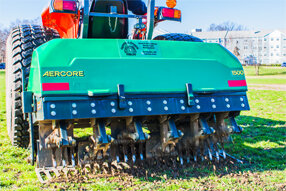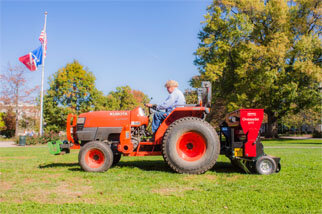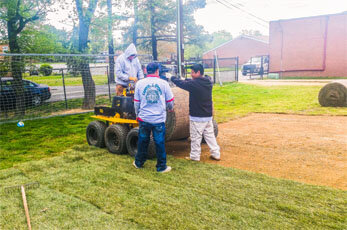A natural turf sports field maintenance program is essential to keep any sports facility in peak performance condition. Installing a natural turf sports playing surface requires careful planning, proper preparation, and execution to ensure the best possible playing conditions. The process can be broken down into several steps, including site assessment, soil preparation, irrigation installation, turf selection and installation, and ongoing maintenance.
The first step in installing a natural turf sports playing surface is to assess the site. The site should be evaluated for factors such as soil type, drainage, sunlight exposure, and water availability. Soil tests may be necessary to determine soil pH, nutrient levels, and other factors that could affect turf growth. Site assessment will also help determine the appropriate turf species to use.
Once the site assessment is complete, the soil must be prepared for turf installation. This may involve removing existing vegetation, rocks, and debris from the site. The soil may also need to be tilled, graded, and leveled to ensure proper drainage and a level playing surface.
Proper irrigation is essential for maintaining healthy turf on a sports playing surface. Irrigation systems may include underground pipes and sprinkler heads, which are designed to deliver water evenly to the playing surface. The irrigation system must be properly designed, installed, and maintained to ensure the turf receives the appropriate amount of water.
Turf selection is critical for the success of a natural turf sports playing surface. The selected turf species must be able to thrive in the local climate and soil conditions. The turf should also be able to withstand heavy foot traffic and frequent use. Turf can be installed by seeding, sodding, or sprigging.
Seeding involves spreading grass seed over the prepared soil and then watering it to promote germination. This method is less expensive than sodding but requires more time and patience.
Sodding involves the installation of pre-grown turf on the prepared soil. Sodding provides an instant playing surface but is more expensive than seeding.
Sprigging involves planting small pieces of turf, called sprigs, onto the prepared soil. This method is less expensive than sodding but requires more time to establish.
Once the turf is installed, ongoing maintenance is necessary to keep the playing surface in good condition.
Maintenance tasks may include mowing, fertilizing, aerating, and pest management. Regular mowing helps maintain a consistent playing surface height, while fertilizing provides the necessary nutrients for turf growth.
Aeration is necessary to alleviate soil compaction and promote root growth. Pest management may involve controlling insects, weeds, and diseases that could damage the turf.
Maintaining natural turf sports surfaces is essential for athletes to perform at their best and stay safe while doing so. To keep the grass healthy and strong, proper maintenance involves regular care and attention to detail.
One of the most important aspects of natural turf maintenance is watering. Turf should be watered deeply and infrequently, allowing the soil to dry out slightly between watering sessions. This helps to encourage deep root growth, which in turn makes the grass more resilient and better able to withstand heavy use. It’s important to water the grass early in the day or late in the evening to avoid evaporation in hot weather.
Regular mowing is also essential for maintaining healthy turf. The frequency and height of mowing will depend on the specific type of grass being used, as well as factors like weather conditions and soil quality. Generally speaking, it’s best to avoid cutting more than one-third of the grass blade length at any given time, as this can cause stress and damage to the plants.
Other important aspects of natural turf maintenance include fertilization, pest control, and aeration. Fertilization helps to provide essential nutrients that promote healthy growth, while pest control measures can help prevent damage from insects or other pests. Aeration involves creating small holes in the soil to allow air, water, and nutrients to penetrate more deeply into the root zone. This helps to reduce soil compaction and improve drainage.
Overall, proper maintenance of natural turf sports surfaces requires a combination of knowledge, skill, and attention to detail. By following best practices for watering, mowing, fertilization, pest control, and aeration, groundskeepers can help ensure that athletes have a safe and high-quality playing surface on which to compete. When done regularly and properly, natural turf maintenance can extend the lifespan of the playing surface, save money on repairs, and reduce the risk of injury to athletes.
One essential part of maintaining a healthy natural turf surface is aeration. This basically means creating small holes in the soil to allow air, water, and nutrients to penetrate deeper into the roots. Aeration can help promote healthy growth, improve drainage, and reduce soil compaction.
There are different ways to aerate natural grass fields, like using spike aeration, solid-tine aeration, or hollow-tine aeration. Each method has its own advantages and disadvantages depending on the soil type and condition of the grass.
Spike aeration involves using a tool with spikes or tines to create holes in the soil without removing any material. It’s a simple and cost-effective method, but it may not be as effective at reducing soil compaction as other methods.
Solid-tine aeration uses a tool with solid points to remove small plugs of soil from the ground. This method can help reduce soil compaction and improve drainage, but it may leave small gaps that need to be filled with sand or other materials.
Hollow-tine aeration is similar to solid-tine aeration but uses tools with hollow points that remove larger plugs of soil from the ground. This method is generally considered the most effective at reducing soil compaction and improving drainage, but it can be more time-consuming and expensive than other methods.
Regardless of the method used, it’s important to aerate natural grass sports fields regularly to ensure optimal performance and safety for athletes. The frequency of aeration will depend on factors like weather, use patterns, and soil quality, but it should generally be done at least once a year for most sports fields.
Overall, proper aeration is a crucial part of natural grass maintenance that can help promote healthy growth and improve playing conditions for athletes. By understanding the different methods for aerating natural turf sports fields and following best practices for implementation, groundskeepers can ensure that their fields remain safe, durable, and high-performing over time.


We can install the highest quality sod on any athletic field construction or renovation project. The types of sod that we install for athletic field construction projects include Bluegrass, Bermuda, and Fescue. Our professional staff can help you determine which type of sod will be the best choice for your athletic field application.
